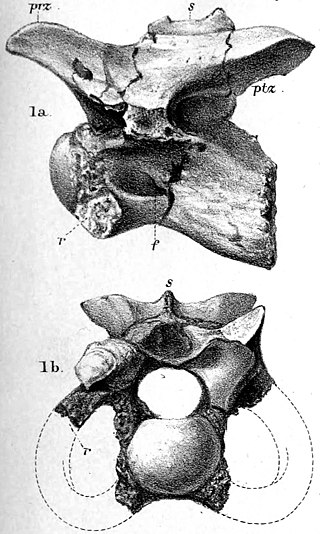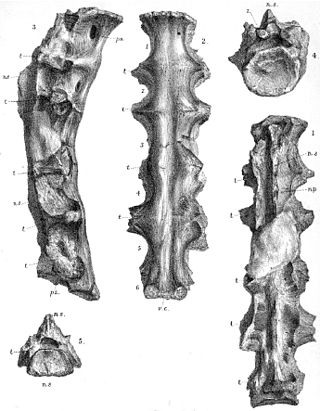
Baryonyx is a genus of theropod dinosaur which lived in the Barremian stage of the Early Cretaceous period, about 130–125 million years ago. The first skeleton was discovered in 1983 in the Smokejack Clay Pit, of Surrey, England, in sediments of the Weald Clay Formation, and became the holotype specimen of Baryonyx walkeri, named by palaeontologists Alan J. Charig and Angela C. Milner in 1986. The generic name, Baryonyx, means "heavy claw" and alludes to the animal's very large claw on the first finger; the specific name, walkeri, refers to its discoverer, amateur fossil collector William J. Walker. The holotype specimen is one of the most complete theropod skeletons from the UK, and its discovery attracted media attention. Specimens later discovered in other parts of the United Kingdom and Iberia have also been assigned to the genus, though many have since been moved to new genera.
The Isle of Wight is one of the richest dinosaur localities in Europe, with over 20 species of dinosaur having been recognised from the early Cretaceous Period, some of which were first identified on the island, as well as the contemporary non-dinosaurian species of crocodile, turtle and pterosaur.

Neovenator is a genus of carcharodontosaurian theropod dinosaur. It is known from several skeletons found in the Early Cretaceous (Hauterivian-Barremian) Wessex Formation on the south coast of the Isle of Wight, southern England. It is one of the best known theropod dinosaurs from the Early Cretaceous of Europe.

Eotyrannus is a genus of tyrannosauroid theropod dinosaur hailing from the Early Cretaceous Wessex Formation beds, included in Wealden Group, located in the southwest coast of the Isle of Wight, United Kingdom. The remains (MIWG1997.550), consisting of assorted skull, axial skeleton and appendicular skeleton elements, from a juvenile or subadult, found in a plant debris clay bed, were described by Hutt et al. in early 2001. The etymology of the generic name refers to the animal's classification as an early tyrannosaur or "tyrant lizard", while the specific name honors the discoverer of the fossil.

Yaverlandia is a genus of maniraptoran dinosaur. Known from a partial fossil skull found in Lower Cretaceous strata of the Wessex Formation on the Isle of Wight. it was described as the earliest known member of the pachycephalosaurid family, but research by Darren Naish shows it to have actually been a theropod, seemingly a maniraptoran. The type species is Y. bitholus.

Aristosuchus is a genus of small coelurosaurian dinosaur whose name was derived from the Greek ἄριστος and σουχος. It shared many characteristics with birds.
Calamospondylus is a genus of theropod dinosaur. It lived during the Early Cretaceous and its fossils were found on the Isle of Wight in southern England. The type species is C. oweni.

Calamosaurus was a genus of small theropod dinosaur from the Barremian-age Lower Cretaceous Wessex Formation of the Isle of Wight, England. It is based on two cervical vertebrae, collected by Reverend William Fox.

Thecocoelurus is a dubious genus of theropod dinosaur from the early Cretaceous period of England. The phylogenetic placement of this genus is uncertain, and it has been referred to an oviraptosaur, an ornithomimosaur, or a therizinosaur by different researchers throughout its history.

Ornithodesmus is a genus of small, dromaeosaurid dinosaur from the Isle of Wight in England, dating to about 125 million years ago. The name was originally assigned to a bird-like sacrum, initially believed to come from a bird and subsequently identified as a pterosaur. More complete pterosaur remains were later assigned to Ornithodesmus, until recently a detailed analysis determined that the original specimen in fact came from a small theropod, specifically a dromaeosaur, making it one of the first dromaeosaurs known to science. All pterosaurian material previously assigned to this genus has been renamed Istiodactylus.
The Vectis Formation is a geological formation on the Isle of Wight and Swanage, England whose strata were formed in the lowermost Aptian, approximately 125 million years ago. The environment of deposition was that of a freshwater coastal lagoon with occasional marine influence after the early Aptian marine transgression, transitioning from the floodplain environment of the underlying Wessex Formation. The primary lithology is of laminated grey mudstones. The Vectis Formation is composed of three geological members: the Shepherds Chine member, the Barnes High Sandstone member, and the Cowleaze Chine member. It is overlain by the fully marine Atherfield Clay Formation, part of the Lower Greensand Group. Dinosaur remains are among the fossils that have been recovered from the formation.

Zuolong is an extinct genus of tetanuran theropod from the Late Jurassic period of China. The type and only species is Z. salleei. The generic name of Zuolong is in honor of General Zu Zōngtáng with the Chinese word "long" which means dragon. The specific epithet "salleei" is in honor of Hilmar Sallee, who funded the expedition which led to the specimen's discovery.

Camarillasaurus is a genus of theropod dinosaur from the Early Cretaceous period (Barremian) of Camarillas, Teruel Province, in what is now northeastern Spain. Described in 2014, it was originally identified as a ceratosaurian theropod, but later studies suggested affinities to the Spinosauridae. If it does represent a spinosaur, Camarillasaurus would be one of five spinosaurid taxa known from the Iberian peninsula, the others being Iberospinus, Protathlitis, Riojavenatrix, and Vallibonavenatrix.

Vectidraco, is a genus of azhdarchoid pterosaur from the Lower Cretaceous of England.

The Ferruginous Sands is a geologic formation in England. It preserves fossils dating back to the Aptian Stage of the Cretaceous period. It consists of "a number of heavily bioturbated coarsening-upward units each comprising dark grey sandy muds or muddy sands passing up into fine-to medium-grained grey to green glauconitic sands." The dinosaur Vectaerovenator inopinatus is known from the formation. Shark teeth are also known from the formation, including those of an indeterminate lamniform shark and Palaeospinax.

Vallibonavenatrix is a genus of spinosaurid dinosaur from the Early Cretaceous (Barremian) Arcillas de Morella Formation of Castellón, Spain. The type and only species is Vallibonavenatrix cani, known from a partial skeleton.

Ceratosuchops is a genus of spinosaurid from the Early Cretaceous (Barremian) of Britain.

Riparovenator is a genus of baryonychine spinosaurid dinosaur from the Early Cretaceous (Barremian) period of Britain. The genus contains a single species, Riparovenator milnerae.

IberospinusIPA:[aɪbiːʌroʊs̠piːnʊs̠] or IPA:[aɪbiːʌroʊs̠paɪnʌs̠] is an extinct genus of spinosaurid dinosaur from the Early Cretaceous (Barremian) Papo Seco Formation of Portugal. The genus contains a single species, I. natarioi, known from several assorted bones belonging to one individual. Iberospinus represents one of five known spinosaurid taxa from the Iberian Peninsula, the others being Camarillasaurus, Protathlitis, Riojavenatrix, and Vallibonavenatrix. It is important for its implications of the geographical origin of Spinosauridae and the suggested presence of an at least semi-aquatic lifestyle early in the evolution of this clade.






























